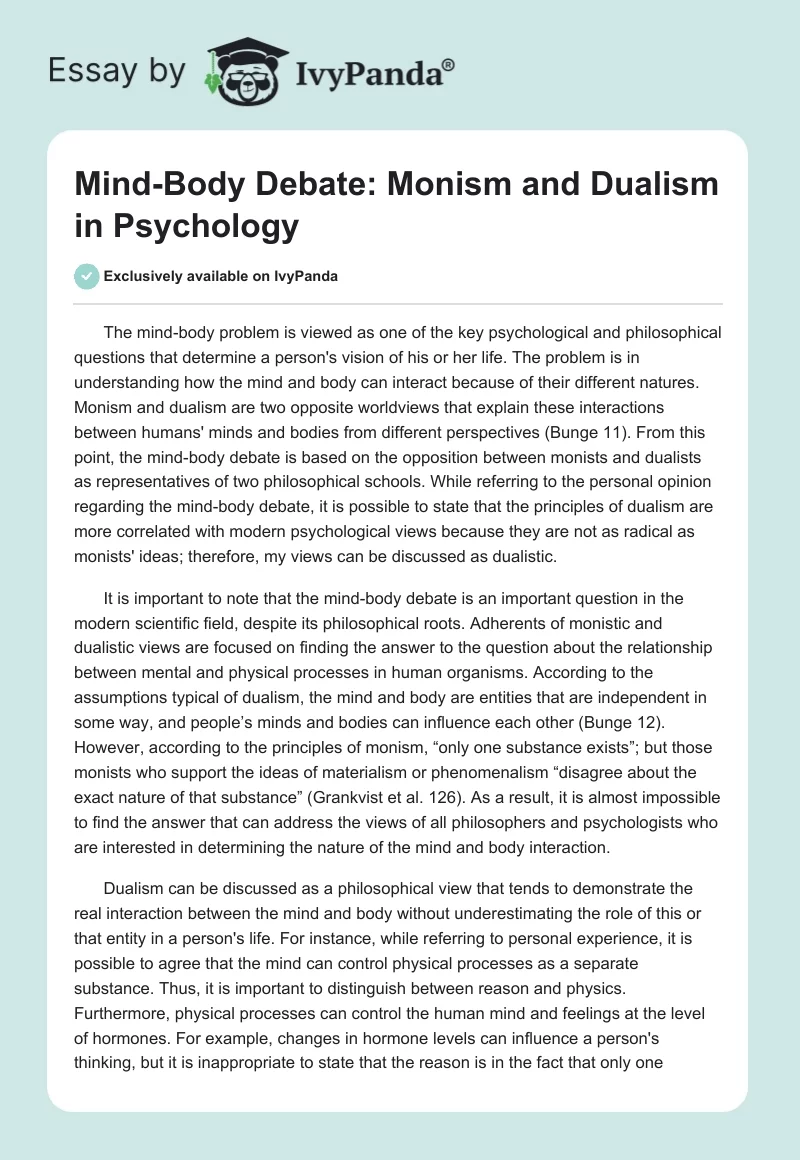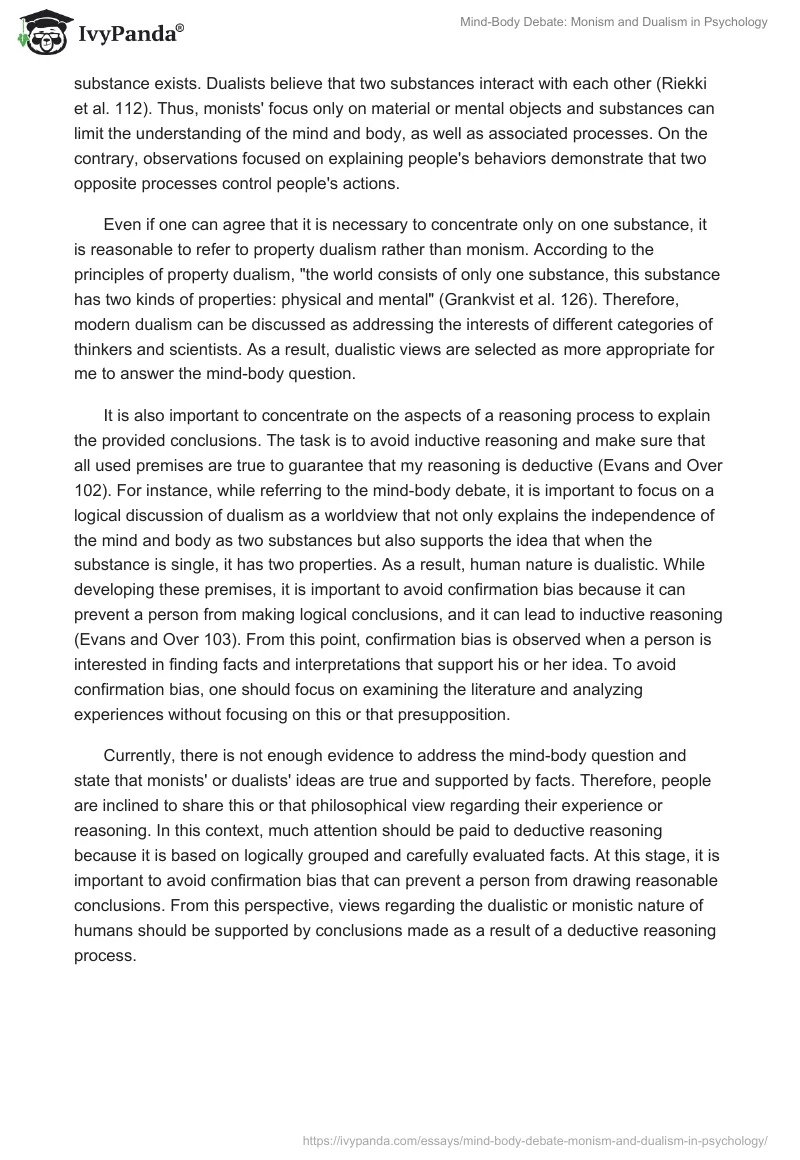The mind-body problem is viewed as one of the key psychological and philosophical questions that determine a person’s vision of his or her life. The problem is in understanding how the mind and body can interact because of their different natures. Monism and dualism are two opposite worldviews that explain these interactions between humans’ minds and bodies from different perspectives (Bunge 11). From this point, the mind-body debate is based on the opposition between monists and dualists as representatives of two philosophical schools. While referring to the personal opinion regarding the mind-body debate, it is possible to state that the principles of dualism are more correlated with modern psychological views because they are not as radical as monists’ ideas; therefore, my views can be discussed as dualistic.
It is important to note that the mind-body debate is an important question in the modern scientific field, despite its philosophical roots. Adherents of monistic and dualistic views are focused on finding the answer to the question about the relationship between mental and physical processes in human organisms. According to the assumptions typical of dualism, the mind and body are entities that are independent in some way, and people’s minds and bodies can influence each other (Bunge 12). However, according to the principles of monism, “only one substance exists”; but those monists who support the ideas of materialism or phenomenalism “disagree about the exact nature of that substance” (Grankvist et al. 126). As a result, it is almost impossible to find the answer that can address the views of all philosophers and psychologists who are interested in determining the nature of the mind and body interaction.
Dualism can be discussed as a philosophical view that tends to demonstrate the real interaction between the mind and body without underestimating the role of this or that entity in a person’s life. For instance, while referring to personal experience, it is possible to agree that the mind can control physical processes as a separate substance. Thus, it is important to distinguish between reason and physics. Furthermore, physical processes can control the human mind and feelings at the level of hormones. For example, changes in hormone levels can influence a person’s thinking, but it is inappropriate to state that the reason is in the fact that only one substance exists. Dualists believe that two substances interact with each other (Riekki et al. 112). Thus, monists’ focus only on material or mental objects and substances can limit the understanding of the mind and body, as well as associated processes. On the contrary, observations focused on explaining people’s behaviors demonstrate that two opposite processes control people’s actions.
Even if one can agree that it is necessary to concentrate only on one substance, it is reasonable to refer to property dualism rather than monism. According to the principles of property dualism, “the world consists of only one substance, this substance has two kinds of properties: physical and mental” (Grankvist et al. 126). Therefore, modern dualism can be discussed as addressing the interests of different categories of thinkers and scientists. As a result, dualistic views are selected as more appropriate for me to answer the mind-body question.
It is also important to concentrate on the aspects of a reasoning process to explain the provided conclusions. The task is to avoid inductive reasoning and make sure that all used premises are true to guarantee that my reasoning is deductive (Evans and Over 102). For instance, while referring to the mind-body debate, it is important to focus on a logical discussion of dualism as a worldview that not only explains the independence of the mind and body as two substances but also supports the idea that when the substance is single, it has two properties. As a result, human nature is dualistic. While developing these premises, it is important to avoid confirmation bias because it can prevent a person from making logical conclusions, and it can lead to inductive reasoning (Evans and Over 103). From this point, confirmation bias is observed when a person is interested in finding facts and interpretations that support his or her idea. To avoid confirmation bias, one should focus on examining the literature and analyzing experiences without focusing on this or that presupposition.
Currently, there is not enough evidence to address the mind-body question and state that monists’ or dualists’ ideas are true and supported by facts. Therefore, people are inclined to share this or that philosophical view regarding their experience or reasoning. In this context, much attention should be paid to deductive reasoning because it is based on logically grouped and carefully evaluated facts. At this stage, it is important to avoid confirmation bias that can prevent a person from drawing reasonable conclusions. From this perspective, views regarding the dualistic or monistic nature of humans should be supported by conclusions made as a result of a deductive reasoning process.
Works Cited
Bunge, Mario. The Mind-Body Problem: A Psychobiological Approach. Elsevier, 2014.
Evans, Jonathon, and David Over. Rationality and Reasoning. Psychology Press, 2013.
Grankvist, Gunne, et al. “The Relationship between Mind-Body Dualism and Personal Values.” International Journal of Psychological Studies, vol. 8, no. 2, 2016, pp. 126-132.
Riekki, Tapani, et al. “Conceptions about the Mind-Body Problem and Their Relations to Afterlife Beliefs, Paranormal Beliefs, Religiosity, and Ontological Confusions.” Advances in Cognitive Psychology, vol. 9, no. 3, 2013, pp. 112-120.


